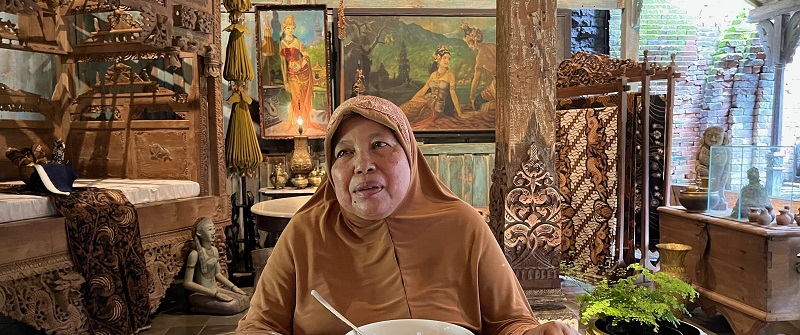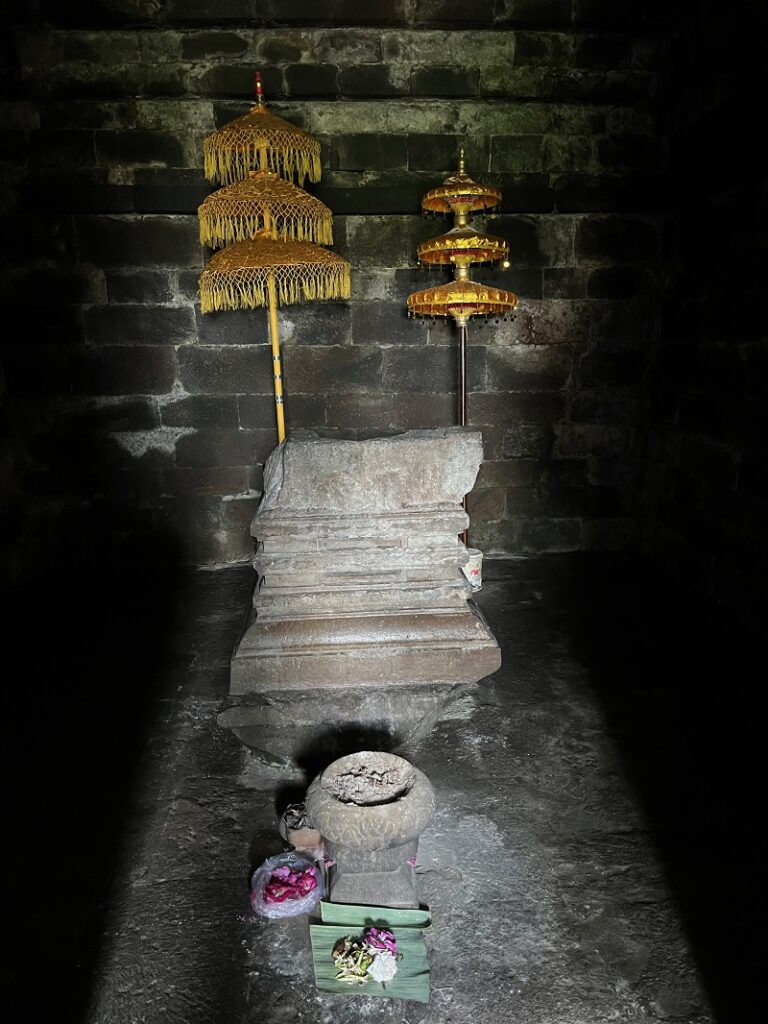
25 Mar Blog: ‘Alhamdulillah!’: Reconsidering colonial loot and its potential return at the Singosari temple in East Java
Gelo – ‘disappointing and saddening’, in Javanese – is a good word to describe the feeling that might arise when visiting the thirteenth-century Singosari temple near Malang in East Java. Three of the temple’s four niches are empty, there were three amazing, giant statues representing the goddesses Bharaiva, Ganesa and Durga should be shining in all their glory. The awayness of these statues from Singosari reflects acts of structural injustice, the outcome of which is also visible in the Netherlands. But the more interesting question may be how their absence has mattered there, at Singosari, until today.
The statues were carried away in 1804 by Dutch colonial administrator Nicolas Engelhard, who first placed them on his estate De Vrijheid (Freedom) on Java’s East Coast. Then, in 1814, he had them transported to the Netherlands as a prestigious gift to the new King Willem I, to honour his patria and himself. After being moved between various institutions reflecting different scholarly interests, the statues ended up in Leiden, specifically in the National Museum of Ethnography, which today forms part of the Dutch National Museum of World Cultures. Here they have been the eye-catching beauties of the Indonesia section.
Looted objects, looted ‘Art’?
The statues have been appreciated in different ways over time – as objects of a particular religious cult, as questions for archaeological or ethnographic study, as masterpieces of Asian Art, and – today, in the Dutch debate of restitution – as roofkunst, or ‘looted art’. These changes in valuation and referencing highlight the arbitrariness of the borders between various domains of knowledge. More importantly, a study of the changing way in which the statues have been valued provides insights into the politics, moral economy and subjectiveness of aesthetic standards that transform ancient objects made for religious/political aims into Art with a capital A. And, as various scholars of material culture, history of science, collecting and heritage politics have pointed out before, they obfuscate those structures of (epistemic) violence that are inherent to collecting and trading practices – of museums and private Asian Art lovers – that cause objects to move, from an ancient temple to museum cases or private cabinets. A focus on the questions of how and why such objects have been appreciated and transformed into museum objects ‘here’ – in the Netherlands, where I write this blog – may, however, lead us to drift away from how they would have been valued, and still are valued, ‘there’, at the temple of Singosari. Nor would it, therefore, make much sense to start a discussion here about the problematic concept of Roofkunst (‘Looted Art’) as used in the restitution debate. Whether and how we should define the statues of Singosari as Art is arbitrary and the decisions on this question are always political too. It is clear, though, that the statues were stolen, in a colonial administrative context. But what matters here is the saddening emptiness of the Singosari temple’s niches.
Empty niches, full of meaning
The emptiness of the niches at Candi Singosari becomes all the more gelo when we look at the fourth niche. There, very much present, we find a giant stone statue of Siva (as Batara Guru or Agastya), which visitors honour and bring small offerings to (incense, and flowers and rice in banana leaves). And yet such offerings can also be seen in the empty niches – an act of daily care provided by local kebatinan (spiritual) Javanese, or by (Hindu) Balinese visitors. So, even when they are not physically there, and instead are to be found in Leiden, the statues continue to hold meaning in Singosari. Caretakers, guards and visitors miss them. People who work on and around the site know the names of the goddesses they represent. They know that one of them, Bharaiva, was made as a deified version of King Kertanagara, the last king of the East Javanese Singosari Kingdom, and that it is therefore important in terms of understanding local history. And they know that these three statues have been kept, for a very long time now, in a prestigious museum in the Netherlands. I learned this on a rainy day in November 2022 when I visited the site with students and teachers from the history department of Universitas Negeri Malang (State University of Malang). We spoke with guards, visitors and people living and working around the site. However, most of them, as we found out, did not yet know that only a month before, on 18 October 2022, the Indonesian government had put the three statues on a list of objects it was reclaiming, as set out in an official letter to the Dutch government, with the aim of restitution to Indonesia. This official request reached the Dutch government in The Hague, as well as the Dutch media, but the news had not, or not so clearly, resonated in Singosari, and certainly not in the way it came to be discussed in Dutch and international media. In such media coverage, proponents of restitution spoke of a form of ‘healing’, and of rectifying historical injustice, and opponents deemed this an attack on enlightened science and empathic connoisseurship.
All of this illustrates how the debate on the decolonization of museums and restitution as it evolves in the Netherlands, and between heritage institutions and national governments who are all driven by diplomatic interests, is completely detached from what seems to be the most important question and context to look into: how do the objects under discussion matter to the site of origin and its keepers, past and present? Why and how do they care? And what can these objects tell us about local histories, beyond the national framings of colonial and Indonesian nationalist history?
The answers to these questions are neither clear nor unambiguous. Some of the people we spoke to at Singosari deemed the fate of the statues entirely a responsibility of the Indonesian government. They thought the statues safer in the National Museum in Jakarta than at the temple. But we learned that there are important ‘alternative’ stories to tell – stories that seem to be missing from the grand narratives of colonial and national history, from ethnographic museums and Art, or from the debate on restitution. Stories that show how and for whom the temple is relevant at its location, how it is continuously being made and remade into something meaningful. In particular, the experiences of the juru kunci (those who have been in charge of the temple for generations in a more traditional role, across colonial and postcolonial regimes), provide an intriguing long-term perspective on the matter.
Key holders
Gelo – this is how Ibu (Mrs) Siti Chotimah, a former traditional caretaker (juru kunci, literally ‘key holder’) of the temple, expressed her concern when I asked her what the absence of the statues meant to her. Ibu Chotimah (born in 1957) comes from a family whose members have served for at least four generations as juru kunci of the Singosari temple. She is Muslim, wears a jilbab and long dress, and served as a juru kunci for the temple in the 1970s and 1980s. In late colonial times, Chotimah’s grandmother, Sri Latifa, fulfilled this role. She kept it clean and, as a part of her duties, placed incense and other small offerings in the niches. This caring role was handed over to her by her father or mother, who in turn had taken over from their parents. Ibu Chotima’s nephew Candra was a juru kunci too, in the 1990s. He now works as a historian at the University in Malang. It was Candra who introduced me to his aunt.
During our conversation with Ibu Chotimah on the history, continuities and discontinuities in the work and life of the juru kunci, one of Ibu Chotima’s responses unsettled me. If only for its relief-giving spontaneity, I deem her response rather meaningful. I couldn’t think of a better basis for this blog. I asked what she thought of the new formal request made by the Indonesian government to the Dutch government for the return of the statues to Indonesia, pointing out that there was a big chance of restitution. She hadn’t heard about this, but when she realized what my question implied, her response, accompanied by a relieved sigh, could not have been clearer: ‘Alhamdulillah!’.
Photos
Photo (above): Siti Chotimah, former juru kunci of the Singosari temple, in Singosari. Author’s photo, with permission, November 2022.
Photo (below): One of the niches of the Singosari temple. Author’s photo, November 2022.

Author
Marieke Bloembergen is a cultural historian and senior researcher at KITLV, and professor in Heritage and Postcolonial Studies in Indonesian History at Leiden University’s Colonial and Global History Department. Her research interests concern the political dynamics of cultural knowledge production in colonial and post-colonial Indonesia. Read more.




No Comments